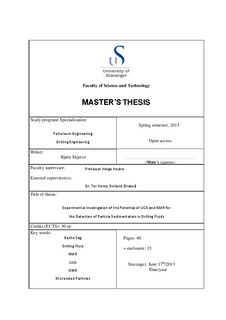| dc.contributor.author | Skjerve, Bjørn | |
| dc.date.accessioned | 2013-11-13T16:22:09Z | |
| dc.date.available | 2013-11-13T16:22:09Z | |
| dc.date.issued | 2013-06-17 | |
| dc.identifier.uri | http://hdl.handle.net/11250/183508 | |
| dc.description | Master's thesis in Petroleum engineering | no_NO |
| dc.description.abstract | Both ultrasound and Nuclear Magnetic Resonance (NMR) have previously been investigated for the potential of monitoring barite sag in drilling fluids. The Ultrasonic Cement Analyzer (UCA) registers the speed of ultrasound waves travelling through a media, which is dependent on the speed of sound of the base fluid, density stratification, particle concentration, shape and size. The NMR measures the longitudinal and transverse relaxation time of the fluid, being dependent on three relaxation mechanisms. These are bulk relaxation, depending upon physical properties such as viscosity; surface relaxation, that accounts for the effect of contact between fluid and solids; and relaxation due to molecular diffusion.
An experimental study has been performed with the aim to investigate the ability of these two apparatus to detect sag in low sag potential drilling fluids with micronized barite. Experiments have been carried out on four different oil water ratios. Direct weight measurement has been performed using a modified atmospheric consistometer, in order to evaluate the behavior of the particles in the drilling fluid at a static condition.
Comparison of the results from the UCA and the NMR with the direct weight measurement have indicated possibilities and restrictions in the use of these two methods.
The UCA has showed potential in detecting accumulation of particles, as sediment beds are formed at the bottom of the test cell. A clear trend with an increasing transit time was indicated to take place after accumulation of approximately 3 grams of particles.
1D profile experiments performed by the use of a bench-top NMR spectrometer have shown potential in detecting sediment accumulation at the bottom of fluid samples. However, it seems like this test method may have a limited sensitivity restricting the gain in applying this test method on low sag potential drilling fluids.
It has been observed that transverse relaxation time, T2, changes with changing oil water ratio. As the number of signal peaks and their placement on the axis representing the relaxation time are probably representing hydrogen nuclei in different structural configurations, this measurement technique might also be applicable in emulsion stability analysis. | no_NO |
| dc.language.iso | eng | no_NO |
| dc.publisher | University of Stavanger, Norway | no_NO |
| dc.relation.ispartofseries | Masteroppgave/UIS-TN-IPT/2013; | |
| dc.subject | petroleumsteknologi | no_NO |
| dc.subject | boreteknologi | no_NO |
| dc.subject | barite sag | no_NO |
| dc.subject | drilling fluid | no_NO |
| dc.subject | NMR | no_NO |
| dc.subject | micronized particles | no_NO |
| dc.subject | UCA | no_NO |
| dc.subject | OWR | no_NO |
| dc.subject | borevæske | no_NO |
| dc.title | Experimental investigation of the potential of UCA and NMR for the detection of particle sedimentation in drilling fluids | no_NO |
| dc.type | Master thesis | no_NO |
| dc.subject.nsi | VDP::Technology: 500::Rock and petroleum disciplines: 510 | no_NO |
